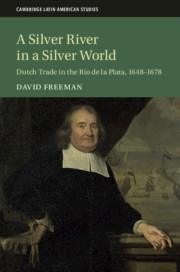Book contents
- A Silver River in a Silver World
- Cambridge Latin American Studies
- A Silver River in a Silver World
- Copyright page
- Dedication
- Contents
- Acknowledgments
- Maps
- Introduction
- 1 The Silver World
- 2 The Silver River
- 3 Golden Connections
- 4 Dutch Ships and Dutch Men on the Río de la Plata
- 5 Conflicting Ownership
- 6 Silver Tongues
- 7 Silver Politics on the Estuary
- 8 The Silver River Runs Dry
- Bibliography
- Index
- Series list continued from page ii
8 - The Silver River Runs Dry
Published online by Cambridge University Press: 18 April 2020
- A Silver River in a Silver World
- Cambridge Latin American Studies
- A Silver River in a Silver World
- Copyright page
- Dedication
- Contents
- Acknowledgments
- Maps
- Introduction
- 1 The Silver World
- 2 The Silver River
- 3 Golden Connections
- 4 Dutch Ships and Dutch Men on the Río de la Plata
- 5 Conflicting Ownership
- 6 Silver Tongues
- 7 Silver Politics on the Estuary
- 8 The Silver River Runs Dry
- Bibliography
- Index
- Series list continued from page ii
Summary
In a 1672 summary of the original purpose for the establishment of an audiencia in Buenos Aires, the government of Carlos II (1661–1700) wrote that, in 1660, reports “were being received from England and Holland about how much the vassals of those states were engaged in commerce with the Ports of the Indies and particularly with that of Buenos Ayres.” These reports included the information concerning “the great returns of silver that they [the English and Dutch] gained from the exchanges that they carried out, and about the growing profits that they were having due to the tolerance of the Governors; each day the excess was becoming greater.” Referring to the situation in the early 1660s, the summary continued, “It was recognized that where the most excess had occurred had been Buenos Ayres, during the time that Pedro de Baygorri governed that city.” Under Baygorri’s governorship, “there had been many English, French, and Dutch ships … admitted, introducing goods to Spaniards and carrying away great sums of silver … extracted at the mines of Potosí.” Finally, it was estimated that “There was imported more than twelve million pesos in merchandize on which were paid very little taxes for the Royal Treasury but great sums to the Governors on the pretext of permitting ship repairs, all very malicious.…”
- Type
- Chapter
- Information
- A Silver River in a Silver WorldDutch Trade in the Rio de la Plata, 1648–1678, pp. 180 - 200Publisher: Cambridge University PressPrint publication year: 2020

